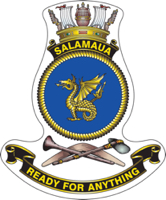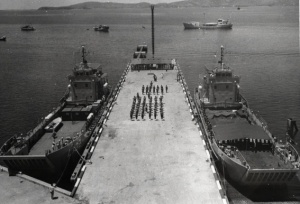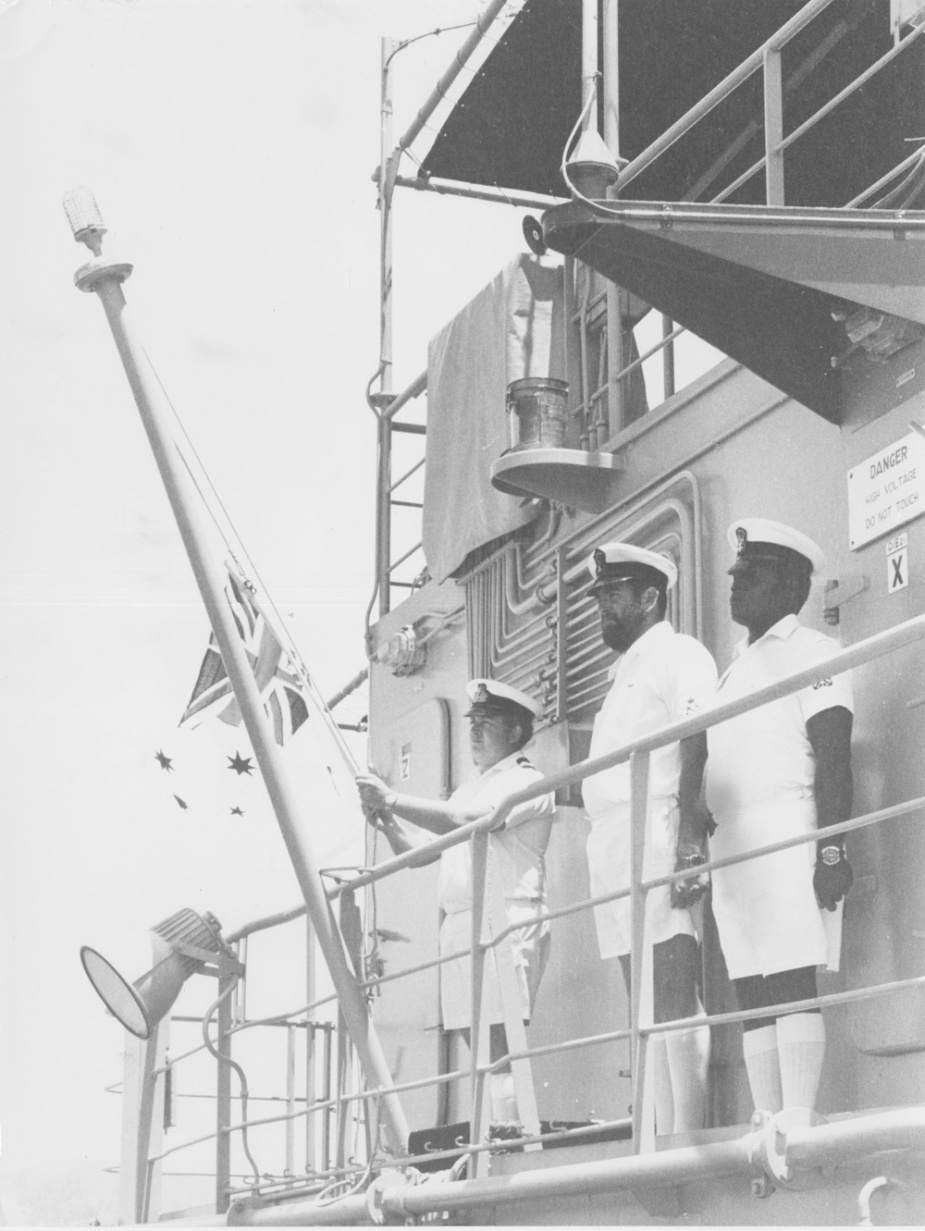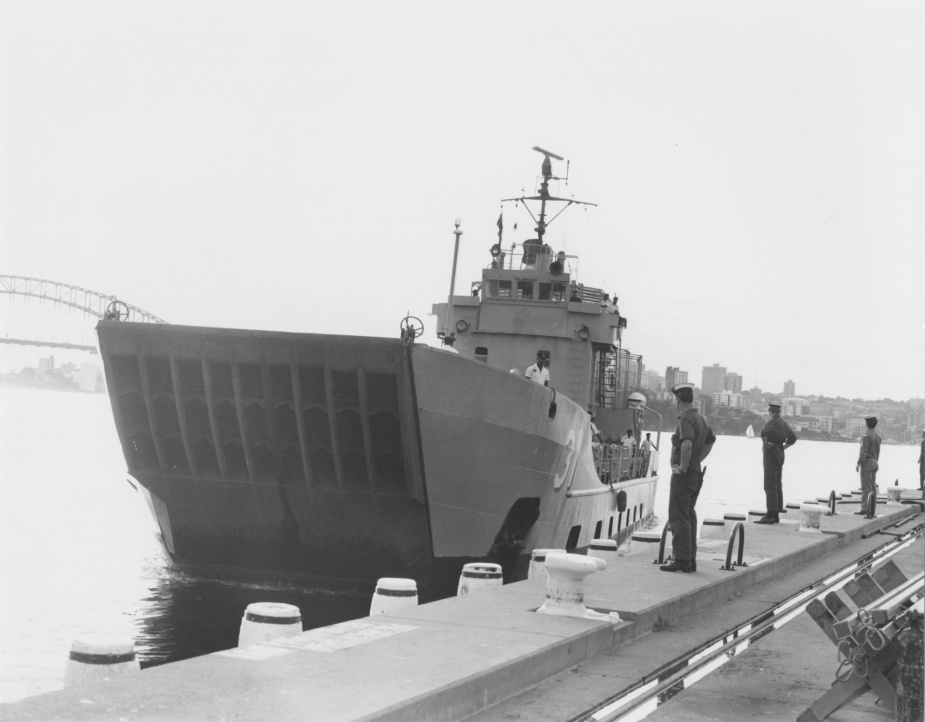HMAS Salamaua
| Class |
Balikpapan Class |
|---|---|
| Pennant |
L131 |
| Builder |
Walkers Ltd, Maryborough, Queensland |
| Launched |
26 July 1972 |
| Commissioned |
19 October 1973 |
| Decommissioned |
26 November 1974 |
| Dimensions & Displacement | |
| Displacement | 310 Tonnes Light |
| Length | 44.5 metres |
| Beam | 16.1 metres |
| Draught | 1.9 metres |
| Performance | |
| Speed | 10 knots |
| Complement | |
| Crew | 13 |
| Armament | |
| Guns | Two 50-calibre machine guns |

The Landing Craft Heavy (LCH) HMAS Salamaua was commissioned at HMAS Moreton, Brisbane on 19 October 1973 under the command of Lieutenant Walter Kenneth Scott, RAN. The Commissioning Officer was Brigadier Bruce Alexander McDonald DSO, OBE, MC (Chief of Staff, Headquarters Northern Command). She was named after a battle, in September 1943, involving Australian troops that resulted in the capture of the major Japanese base at Salamaua, in the Huon Gulf area of Papua New Guinea.
Salamaua sailed from Moreton on 22 October to commence her work up, in Moreton Bay, which concluded on 2 November. Her work up included a number of practice beachings at Tangalooma (Moreton Island), Bulimba Hard (Bulimba Army Depot) and Bird Island. Her first amphibious tasking took place on 20 November when she loaded six vehicles, including three armoured personnel carriers of the 4th Cavalry Regiment, at Bulimba Hard and sailed north to offload these at Snapper Point, near Tin Can Bay, on 21 November. Crew members of the soon to be commissioned landing craft heavy Buna were also embarked for familiarisation training in amphibious operations.
For the remainder of November Salamaua supported army training exercises along the Queensland coast including beachings at Dunwich, Amity Beach, Tin Can Bay and Snapper Point. On 26 November Salamaua was forced to take evasive action when the trawler Vaya Con Dios failed to give way in the vicinity of Point Cartwright. A letter of complaint was forwarded to the Queensland Marine Board which subsequently advised that while the trawler skipper was in breach of the International Regulations for the Prevention of Collisions at Sea, that no action could be taken as trawler skippers were not required to be certified as being familiar with these rules.
Salamaua was berthed at Moreton throughout December 1973 and the early part of January 1974 for the Christmas leave/maintenance period. She then conducted an intermediate docking at Peter’s Slip, at Kangaroo Point, from 7-16 January 1974. On completion of this work Salamaua conducted stern anchor trials, a families day and a beaching at Tangalooma on 19 January. She conducted exercises with HMA Ships Wewak and Brunei on 21 January and then returned alongside Moreton. Heavy rain began to fall on 24 January and by the following day the Brisbane River had risen significantly and all lines were quadrupled up. The ships lines were later increased to include extra flexible steel wire rope due to the surging caused by the flood waters. This bad weather was experienced along the entire east coast of Australia and resulted in heavy flooding in coastal areas; with Brisbane quite badly affected with thousands of homes and businesses in the city flooded.
On Sunday 27 January there was a scare when it was reported that the 62,000 ton tanker Robert M Miller had broken her moorings, at Kangaroo Point, and was floating down stream. Fortunately her one remaining anchor was let go and held thus preventing a possible disaster. The Brisbane River peaked on 28 January and Salamaua’s planned deployment to Cairns, for hydrographic survey duties, was delayed and she and the other landing craft heavy remained alongside at Moreton until the bad weather had cleared.
Salamaua finally sailed on 4 February with additional hydrographic personnel embarked and, after a short stop at Fitzroy Island, she arrived at Cairns on 8 February. She sailed on 11 February to commence hydrographic survey work at Barrow Island, North Bay Point, Hales Island, Pipon Island and Flinders Island. During this period five personnel were landed from Salamaua to climb Mount Flinders (1051 feet). The survey vessel HMAS Flinders was sighted on 15 February, and both ships exchanged signals and later that day the patrol boat HMAS Barbette secured alongside Salamaua for the night; which allowed the two ships personnel to enjoy a smorgasbord onboard Salamaua. She returned to Cairns on 20 February.
On 4 March, she sailed from Cairns returning to the survey grounds in the Pipon Island area and establishing a tide pole camp at Cape Melville. Salamaua proceeded to Cooktown on 8 March, where she offloaded some unserviceable equipment the following day. She then returned to Flinders Island. While en route she conducted a light line transfer of recreational movies with the patrol boat HMAS Bayonet. Survey work then continued in the vicinity of Owen Channel, Ninian Bay, Clack Island and Coquet Island. On 14 March she rendezvoused with the patrol boat HMAS Barricade to transfer mail and the following day the LCH returned to Cairns. On 22 March the Fleet Commander, Rear Admiral David Wells, CBE, DSC, RAN conducted an inspection of the ship.
The next day she sailed to continue survey work at Clack Island, Rocky Islet and Stokes Bay but south easterly winds at force 7-9 often hampered the work and Salamaua was frequently required to seek shelter. Her charge engineering sailor became ill and he was transferred to the patrol boat HMAS Samarai for additional treatment in the early hours of 26 March. The following day she rendezvoused with her sister ship HMAS Labuan to take on additional stores and equipment that had been freighted north from Brisbane. Salamaua then returned to Cairns on 5 April to undertake maintenance which was completed on 16 April.
She sailed that afternoon to resume survey work in the vicinity of Clack Island, Stokes Bay, North Bay Point and Pipon Island. A mail transfer, with HMAS Barricade, occurred on Anzac Day before she returned to Cairns on 26 April to refuel. Salamaua departed Cairns on 29 April and once again commenced survey work around Pipon Island, Clack Reef and Blackwood Island. She rendezvoused with HMAS Barricade on 3 May and the patrol boat secured alongside Salamaua, at anchor, for the night and sailed the next day. On 5 May while anchored in Owen Channel the patrol boat HMAS Advance also secured alongside the LCH for the night.
While recovering survey equipment from Clack Reef on 7 May 1974, one of Salamaua’s men slipped and suffered a suspected broken leg. He was brought back on board for initial treatment before being transferred to HMAS Bayonet which took the injured sailor to Cairns. Salamaua completed her survey duties the next day and returned to Cairns on 9 May. She sailed from Cairns on 18 May and proceeded to Townsville where she berthed the following day. While in Townsville eight M113 armoured personnel carriers were craned onboard. Salamaua sailed from Townsville on 20 May and proceeded to Rosslyn Harbour, south of Yeppoon, where the M113s were offloaded at the Rosslyn boat ramp on 22 May.
The LCH arrived back at HMAS Moreton on 24 May to allow her crew some rest after their first long deployment. On 4 June Salamaua sailed in company with HMAS Labuan to take part in Exercise KANGAROO ONE at Shoalwater Bay. While en route she rendezvoused with two other LCHs (HMA Ships Buna and Betano) before arriving at Otterbourne Island on 7 June, where she formed part of TG 329.6. Her first task was to establish a coast-watching station on nearby Hexham Island and, following the arrival of an amphibious task group (TG 329.5) on 10 June, she conducted a trial embarkation of vehicles from the landing ship dock, USS Alamo, which required Salamaua to enter the well dock. An initial attempt to land these vehicles at Red Beach (Sabina Point) was unsuccessful due to an unsuitable beach gradient and falling tide, but was achieved later in the day. Salamaua refueled from the destroyer escort HMAS Stuart on 12 June before securing alongside the destroyer tender HMAS Stalwart, on 13 June, to effect repairs to her bow door. More vehicle embarkation training was conducted, in company with HMAS Buna, on 14 June, with the amphibious transport USS Juneau and the tank landing ship USS Bristol County.
On 16 June, Salamaua sailed for Rosslyn Harbour, arriving on 18 June, to embark eight M113 armoured personnel carriers which were then offloaded at Cape Pallarenda jetty on 20 June. She then proceeded to Townsville where she berthed overnight in order to repair a faulty radar. On sailing the next day, in company with HMAS Betano, bad weather was encountered and the two LCHs were forced to anchor near Cape Upstart on 22 June and in Cid Harbour until 23 June. They finally arrived at Rosslyn Harbour on 24 June to embark earth moving vehicles of the 2nd Field Engineer Regiment before disembarking them at Brisbane on 26 June. Salamaua then berthed at HMAS Moreton with her part in Exercise KANGAROO ONE complete. The next activity for Salamaua was a week-long warranty slipping program at Cairncross Slip, at Hamilton Reach, during 2-10 July to undertake a review of the ship’s hull; especially the bow door securing mechanism that had been problematic during the previous few months. Following this she returned to Moreton where she commenced the winter leave/maintenance period with half the crew on leave at any one time.
Salamaua was slipped again on 5 August at Peters Slip for cleaning and repainting of her fresh water tanks and modification to heads and showers and mess-decks in preparation for her impending transfer to the Papua New Guinea Defence Force. What was supposed to be a five day activity dragged out until 22 August due to union disputes and a national transport strike which stopped the necessary paint needed being delivered from Sydney. On 22 August Salamaua was cold moved to the Evans Deakin fitting our wharf, Kangaroo Point, to enable the work to be completed. She finally arrived back at Moreton on 29 August. On 4 September, Salamaua sailed to Bulimba Army Depot to load Department of Housing and Construction vehicles and the next day proceeded to Moreton Island, to offload them, before returning to Moreton the next day.
Commander Robert Barrell, RAN (Commander First Australian Landing Craft Squadron) conducted the ships first, and only, annual inspection of 6 September 1974. On 9 September she departed Moreton and proceeded south to undertake a steel delivery voyage from Sydney to Melbourne (due to the national transport strike a large quantity of steel in Sydney could not be delivered to Williamstown Dockyard for ship repair tasks). Salamaua also embarked three Naval Reserve Cadets, and a cadet instructor, for the voyage to Sydney. She arrived in Sydney on 11 September and went alongside the Garden Island fitting out wharf to load 131 tonnes of steel plate. Due to trade union difficulties this was not completed until 19 September and the final securing of the load was performed by her ship's company.
Salamaua departed Sydney late on 19 September and steamed south into rapidly worsening weather. On rounding Gabo Island, on 20 September she was struck by force 8-9 winds and heavy seas which caused the LCH to pound violently into the oncoming sea, causing the cargo to shift. Lieutenant Scott reversed course and sought shelter in Twofold Bay until the morning of 21 September when she attempted to head south again. Similar conditions were encountered near Gabo Island forcing the ship to anchor in the lee of the island until the morning of 22 September. She eventually arrived at Port Phillip Bay early on the morning of 24 September and went alongside at Williamstown to commence unloading.
Rolling strikes and a refusal by dockyard workers to work on weekends and public holidays meant that unloading of the steel plate was not completed until 1 October. Salamaua cast off later that day reaching Sydney on 4 October, berthing at HMAS Waterhen. She sailed on 6 October bound for Brisbane and arrived at HMAS Moreton on 7 October. The next day eight members of the Papua New Guinea Defence Force (PNGDF) joined the ship for training in preparation for her transfer in November. On 24 October she sailed for exercises in Moreton Bay with HMAS Buna (also due to be handed over to the PNGDF). She returned to Moreton on 28 October and embarked two officers for LCH familiarisation and returned to Moreton Bay, in company with HMA Ships Balikpapan and Buna, for training. A refrigeration system breakdown forced her to return to Moreton on 29 October but she returned to sea the next day. The exercises concluded on 31 October and Salamaua returned to Moreton overnight before sailing for her operational readiness evaluation on 1 November. On completion of that activity she returned to Moreton that evening.
On 6 November, Salamaua cast off from Moreton and proceeded alongside the destroyer tender HMAS Stalwart to embark a spare propeller shaft after which she returned to Moreton. The next day she proceeded to Bulimba Hard to embark vehicles belonging to the Department of Housing and Construction for delivery to Horn Island in the Torres Strait. On 11 November 1974 she sailed from Moreton, in company with HMAS Buna, for the last time as an RAN vessel.
Salamaua and Buna arrived at Cairns on 15 November and the two LCHs sailed on 18 November to continue their passage northwards. They arrived at Horn Island on 20 November. The embarked vehicles were offloaded the next day and both ships then sailed for Port Moresby which was reached late on the evening of 23 November where both vessels went to anchor. The next morning Salamaua and Buna, flying their paying off pennants, secured alongside the PNGDF marine base jetty.
HMAS Salamaua was decommissioned at 11:30 on Tuesday 26 November 1974 by the Australian High Commissioner to Papua New Guinea, His Excellency Mr Thomas Kingston Critchley, CBE and transferred to the PNGDF. At 12:00 she was commissioned in the PNGDF by Mr Albert Maori Kiki, MHA (Minister for Defence, Foreign Relations and Trade). During her RAN service she had steamed 14713.7 nautical miles. Lieutenant Scott remained in command of Salamaua until he took command of HMPNGS Buna on 3 January 1975.





